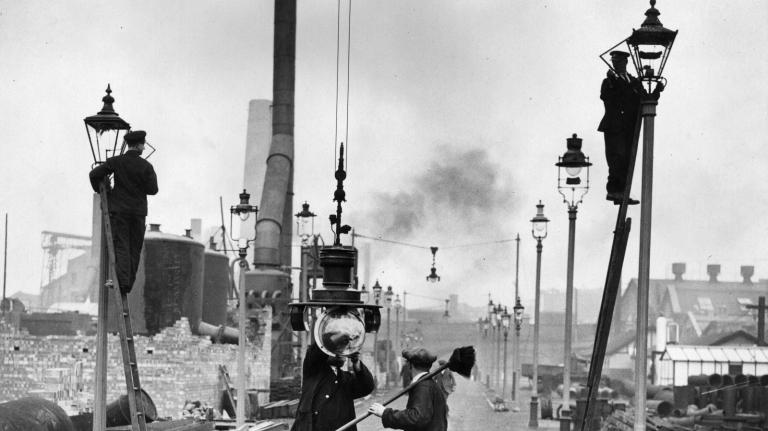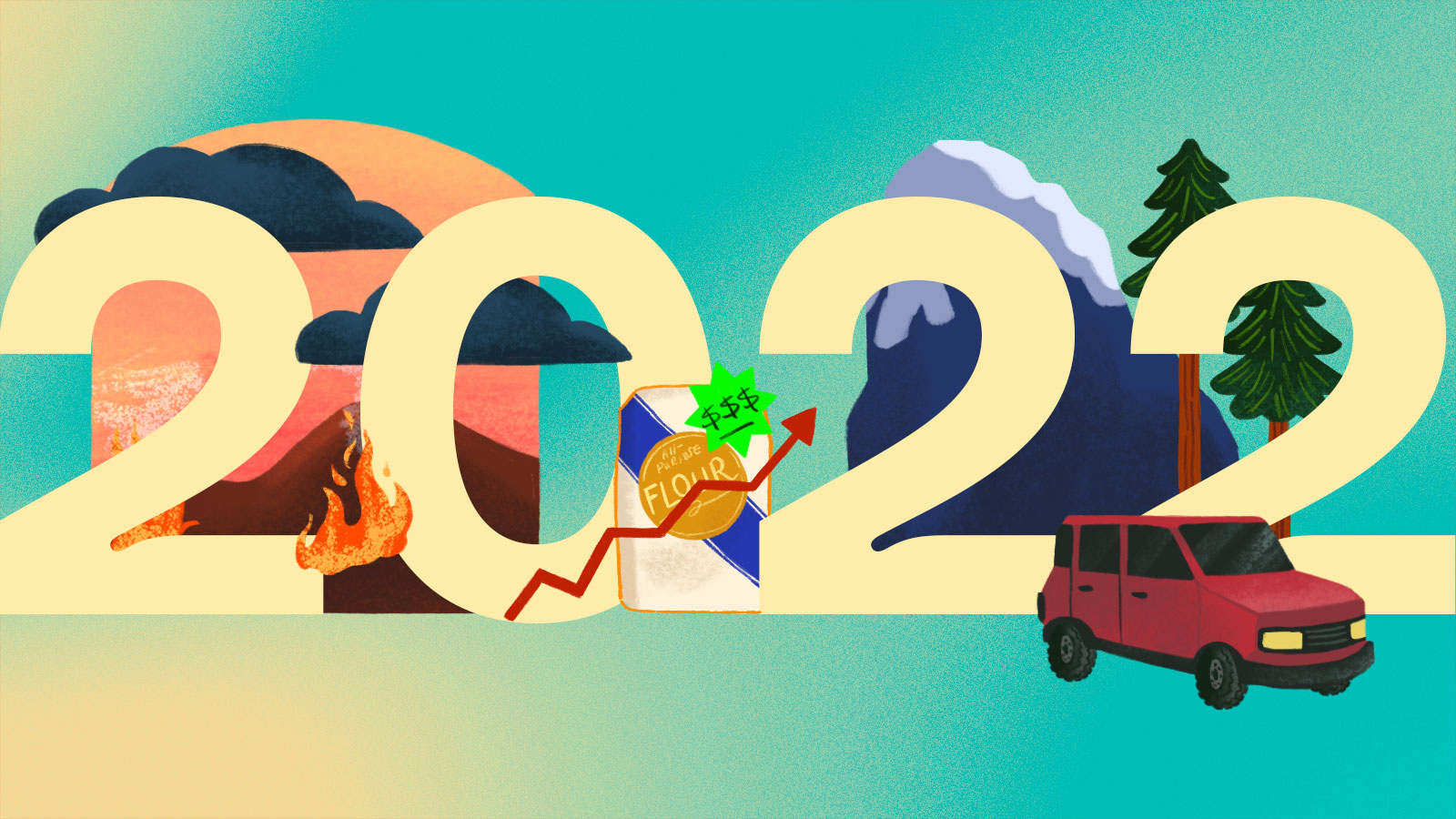It was a sunny morning in July when my editor sent me a hot tip. An unprecedented heat wave in China was ruining the corn and soy crops used to feed pigs, sending the price of pork soaring. And at the same time, hot and dry conditions were sweeping Europe, expected to erase a third of the seasonal harvest of rice, corn, and animal feed in Italy alone.
There was a pattern emerging. A month earlier, the United States had baked in searing temperatures that killed thousands of cattle in Kansas. Everyone was worrying about inflation with grocery bills and energy costs rising. And it looked like the record-breaking heat had been playing a larger role in driving up prices than many people realized. In the course of writing an article that linked these events together, a word was born: heatflation.
As the world overheats, new words and phrases turn up all the time, and old ones gain new meanings. Companies invent terms to sound greener, politicians try to come up with the smartest name for a climate bill, and activists bring brand-new words to life by devising fresh tactics to bring attention to their cause (like throwing soup at famous paintings).
There was so much going on in 2022, the language had some serious catching up to do. This summer, heavy rainfall submerged a third of Pakistan with deadly flooding. China endured a heat wave that was more intense, longer-lasting, and spread over a wider area than any in recent history. Yet the year also held positive developments: In August, Congress passed landmark climate legislation, the Inflation Reduction Act, which President Joe Biden promptly signed into law.
These shifting circumstances shape not only the physical world but also the way we talk about it. Every year, dictionary editors select a word that they think encapsulates the year’s spirit. This time around, Merriam-Webster picked “gaslighting,” Collins Dictionary selected “permacrisis,” and Oxford Languages went with “goblin mode.” Here are Grist’s 10 picks for the words of year, the terms and phrases that best captured the zeitgeist of our fast-changing planet in 2022.

Danger season
The period of the year from May to October plagued with wildfires, hurricanes, and heat waves.
Splashing in pools, eating ice cream cones … and evacuating from wildfires? Summer has earned a new, more sinister name: danger season, The phrase, coined by Erika Spanger-Siegfried, an analyst at the Union of Concerned Scientists, is meant to draw attention to how climate change has supercharged summertime threats. And this summer was no exception. A “heat dome” over France, Germany, Spain, and Britain — which scientists said would have been “virtually impossible” without climate change — led to an estimated 20,000 deaths. “I just want to say straight-up, frankly, 10, 15 years ago, when we would talk about these things, we didn’t want to scare people,” Rachel Cleetus, a policy director at the Union of Concerned Scientists, told Grist earlier this year. “And now we’re scared, we’re terrified, for what we have already unleashed on the world.”

Flash droughts
Sudden dry spells marked by hot, dry air that sucks the moisture out of plants and soil.
You’ve heard of flash floods, outbursts of heavy rain that appear out of nowhere. It’s time to get accustomed to flash droughts, which can crop up in a matter of a week, parching the landscape with little warning. One descended on much of the Northeast in August, endangering the cranberry harvest in Massachusetts. In Oklahoma, 100-degree days dried out the land in July, sending the entire state into a drought. A study earlier this year found that rapid-onset droughts like these are taking hold faster as the climate warms, making them harder to predict, more devastating, and more damaging. Over the past two decades, for example, flash droughts increased more than 20 percent in the Central United States.
Heat pump
An efficient device that “pumps” heat from one place to another, used for both heating and cooling.
It was a big year for heat pumps, a confusingly named device that cools and heats homes. They’re ultra-efficient, using much less energy than traditional heaters, because they use electricity to move heat instead of creating it. Michael Thomas, a journalist and the founder of Carbon Switch, called them “the most overlooked climate solution.” After Russia invaded Ukraine in January, the European Union scrambled to find a way to lessen its dependence on Russian natural gas, enlisting heat pumps as a crucial tool. The technology is also gaining traction in the United States. Washington became the first state to require new buildings to have all-electric heating. Though installing heat pumps can be expensive, the average homeowner could save almost $1,000 on utility bills each year by switching from a fuel oil furnace, preventing four tons of carbon pollution in the process. And yes, in case you were wondering, the technology does work in the cold.

Heatflation
When hot temperatures send prices soaring.
Climate change is gaining a reputation for driving up prices for all sorts of things. After I coined the word heatflation this summer, the term appeared in The Atlantic, Newsweek, and CBS, then made its way around the world in articles from India, Malaysia, and France. In the middle of harvest season in October, food prices in the United States were 10.9 percent higher compared to the year before — even higher than the overall inflation rate of 7.7 percent. Blazing-hot weather was likely one source of the surge. Last year, an analysis from the European Central Bank examined seasonal temperatures and price indicators in 48 countries and found that hot summers had “by far the largest and longest-lasting impact” on food prices. The changing climate has also been a culprit behind higher lumber prices (with trees getting eaten alive by wildfires and heat-loving bark beetles) and insurance premiums (as lenders retreat from risky, flood-prone areas).
IRA
A confusing acronym for the Inflation Reduction Act.
It’s already used as a stand-in for an individual retirement account and the Irish Republican Army, and this year the acronym was pressed into service for President Joe Biden’s landmark climate legislation, the Inflation Reduction Act. Democrats chose the name to appeal to voters as rising prices were top of mind (see entry for heatflation). The IRA directs $369 billion toward renewable power and energy-saving measures, such as tax credits to spur clean energy investments, rebates for buying electric vehicles, and grants to reduce pollution in economically disadvantaged communities. It also opens up new lands and waters to oil and gas leases, a bargaining chip to earn the vote of Democratic Senator Joe Manchin of West Virginia. By 2030, the bill’s programs could help the U.S. cut emissions by 40 percent compared to 2005 levels. The question dividing White House officials and energy nerds now: Do you pronounce it by spelling out the letters (I.R.A.) or like the name Ira?

Nature-rinsing
Using natural imagery in advertisements to give the appearance of being environmentally friendly.
Have you ever seen a commercial where an SUV veers offroad, then takes off through the trees, bounding through a beautiful forest? These kinds of advertisements are so common, it’s easy to miss what’s happening: a type of greenwashing recently labeled nature-rinsing. Polluting companies have long used the beauty of nature — images of wild animals, green plants, and lush landscapes — to clean up their reputation. Marketing research shows that such tactics are often successful, with nature-filled ads eliciting pleasant feelings and improving people’s views of the advertiser’s brand.
Now these images seem to be popping up all over the place. According to a working study analyzing nearly 34,000 social media posts from European companies this summer, environment-related visuals appeared in 97 percent of posts from airlines, and well over half of posts from carmakers and oil companies. “I was shocked by the scale of it when we actually started to quantify it,” Geoffrey Supran, a Harvard researcher who coined nature-rinsing in the report, told Grist earlier this year.
Overshoot
A situation where the world overshoots its climate targets — and then fixes it later.
What’s the difference between the globe warming 1.5 degrees versus 2 degrees C? That half a degree means everything for the existence of small islands and for the well-being of millions of people who would sweat through deadly extreme heat. Unfortunately, we’re all but guaranteed to shoot right past the target of 1.5 degrees C, or 2.7 degrees F. Enter overshoot: a politically popular but scientifically suspect scenario in which the world blows past its climate goals and later brings temperatures back down.
The problem for anyone banking on this turn of events is that some of climate change’s devastating consequences will turn out to be irreversible, as documented in a landmark report from the U.N. Intergovernmental Panel on Climate Change in February. Extinct species will not come back; coral reefs might be permanently lost; ice sheets that melted into the ocean will keep sea levels high. A hotter climate could also set off feedback loops in which damaged forests and thawing permafrost may keep releasing the vast stores of carbon within them. Overshoot hasn’t yet traveled from scientific journals into the vernacular, but it’s sure to come up more often as the mercury continues to rise.

Range anxiety
The worry that your car might die in the middle of a trip.
In 2022, electric vehicles hummed their way into the mainstream. The year kicked off with Super Bowl commercials promoting huge electric SUVs and the long-awaited release of the electric version of the most popular vehicle in America, the Ford F-150 Lightning. But range anxiety might be stopping some people from buying them. In May, a study found that many people in the United States and Germany mistakenly thought that an electric vehicle wouldn’t be able to meet their daily needs. Survey respondents underestimated how many daily tasks an electric vehicle could complete by as much as 30 percent.
The fact is, batteries have been improving for years, and most EVs can now go 200 miles on a full charge, with more than a dozen models getting closer to 300 or 400 miles — like the popular Ford Mustang Mach-E and Tesla Model S. Showing car buyers that these vehicles can easily fulfill most of their activities — if not a road trip to Lake Tahoe — may help speed up the adoption of lower-emissions vehicles. Another thing that could help drivers feel less anxious about getting stranded is a robust network of chargers, which states are getting $5 billion to start building along the Interstate Highway System.
Real zero
A corporate goal to eliminate carbon emissions entirely, no accounting tricks allowed.
Like it or not, you’ve probably heard the phrase “net zero” by now. Corporations and governments have been announcing their intentions to go “net zero” for about a decade, pledging to suck up as much carbon as they emit, often by some far-off date. While the idea works, in theory, critics say these pledges can easily get exploited, leading to some creative accounting. In June, the company NextEra — which owns the large electric utility Florida Power & Light and is a big player in renewables and natural gas — pushed back at ambiguous net-zero pledges by coining real zero. The trademarked term means a company would actually eliminate its emissions without the use of carbon offsets or carbon capture. That is, genuinely zero emissions. While the real-zero goal might be laudable, the whole concept of voluntary corporate goals has drawn criticism for their lack of success: A recent study found that 93 percent of large global companies were on track to miss their emissions-cutting targets.

Soup thrower
A protester who launches soup at art in the name of their cause.
What does tomato soup have to do with climate change? It was a question no one needed to ask until October, when activists with the group Just Stop Oil tossed tomato soup at Vincent van Gogh’s iconic Sunflowers painting, protected by a pane of glass in London’s National Gallery. “Are you more concerned about the protection of a painting or the protection of our planet and people?” asked Phoebe Plummer, one of the soup throwers. Then, activists also flung mashed potatoes at a Claude Monet painting in Germany. The food-launching tactic led museums to tighten security and sparked vigorous debate over whether using an attention-grabbing tactic was helping or hurting the cause. Either way, activists are increasingly turning to civil disobedience as they become frustrated by the world’s slothlike progress on phasing out fossil fuels. In 2022, new words weren’t enough — the high stakes led to new actions, too.





